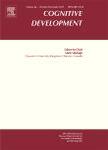版权所有:内蒙古大学图书馆 技术提供:维普资讯• 智图
内蒙古自治区呼和浩特市赛罕区大学西街235号 邮编: 010021

作者机构:Lund Univ Dept Psychol POB 213 SE-22100 Lund Sweden
出 版 物:《COGNITIVE DEVELOPMENT》 (Cogn. Dev.)
年 卷 期:2020年第55卷
核心收录:
学科分类:0402[教育学-心理学(可授教育学、理学学位)] 04[教育学]
基 金:Lund University Department of Psychology Research Funding Swedish Research Council [2015-01206] Swedish Research Council [2015-01206] Funding Source: Swedish Research Council
主 题:Verbal coding Implicit labelling Eye tracking Word-Length effect Language ability
摘 要:How speech coding is used for visual material is critical to understanding the link between language and memory development. Using eye-tracking, the present study examined whether the number of syllables of pictured objects names, monosyllabic versus multisyllabic, predicts looking time at the stimuli-objects in the context of a memory task, thereby indicating verbal recoding. The children s (N = 39, ages 5-7 years) language ability was also considered. Younger children (5;1-6;3 years) did not appear to sub-vocally recode the verbal labels of visual stimuli during encoding, whereas older children (6;4-7;3 years) who were already attending elementary school looked longer at objects with multisyllabic labels. Notably, it was primarily the less verbally competent among those children who contributed to the effect. Thus, our results demonstrate, for the first time, that young children s sub-vocal verbal processing when trying to memorize visual stimuli may be contingent upon verbal competence.